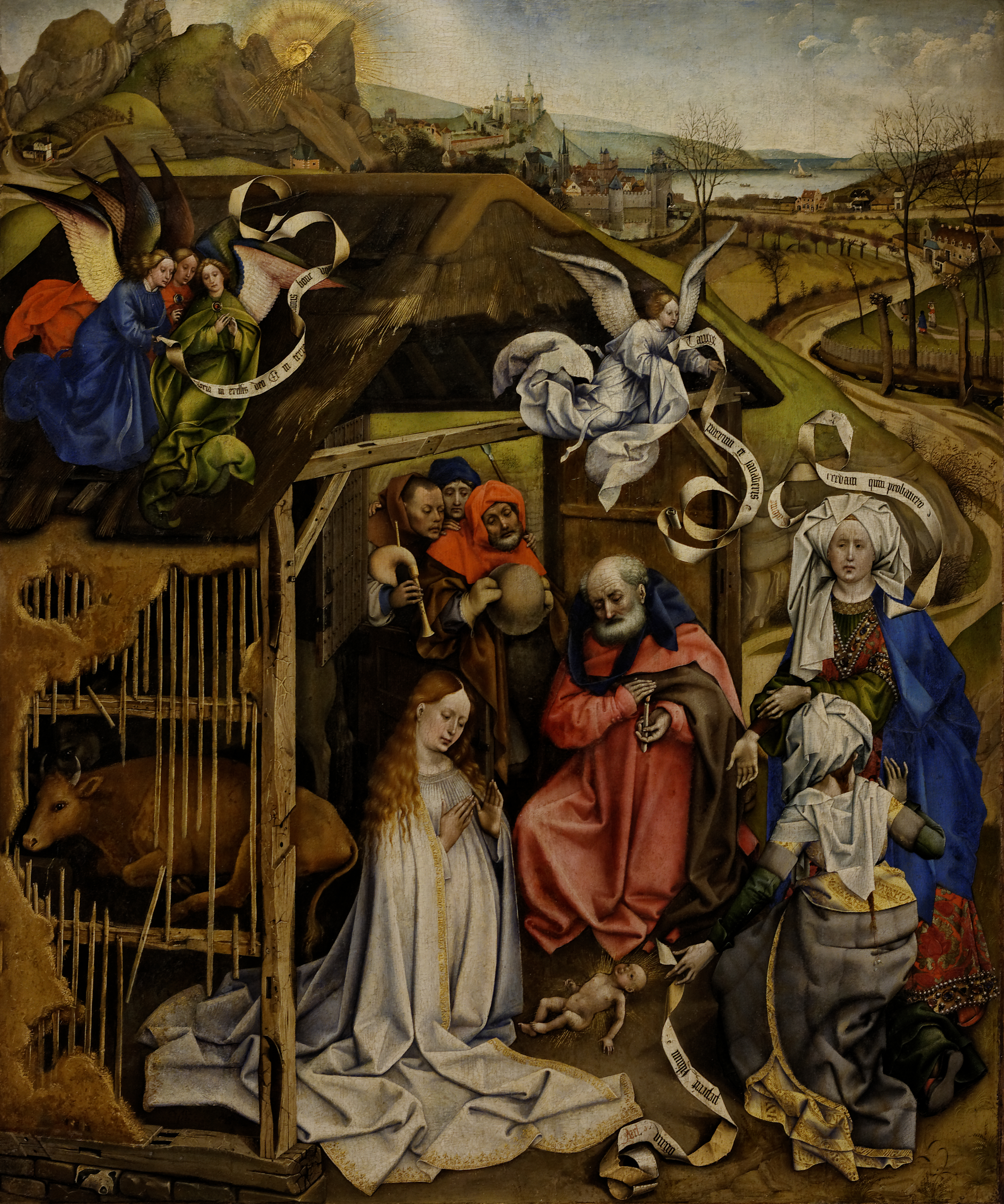Nativity (Campin) on:
[Wikipedia]
[Google]
[Amazon]
 ''Nativity'' is a
''Nativity'' is a
At the Musée des Beaux-Arts de Dijon
(fr) {{ACArt 1420s paintings Paintings by Robert Campin Campin Angels in art Cattle in art Campin
 ''Nativity'' is a
''Nativity'' is a panel painting
A panel painting is a painting made on a flat panel of wood, either a single piece or a number of pieces joined together. Until canvas became the more popular support medium in the 16th century, panel painting was the normal method, when not paint ...
of c. 1420 by the Early Netherlandish
Early Netherlandish painting, traditionally known as the Flemish Primitives, refers to the work of artists active in the Burgundian and Habsburg Netherlands during the 15th- and 16th-century Northern Renaissance period. It flourished especiall ...
painter Robert Campin
Robert Campin (c. 1375 – 26 April 1444), now usually identified with the Master of Flémalle (earlier the Master of the Merode Triptych, before the discovery of three other similar panels), was the first great master of Early Netherlandish paint ...
, now in the Musée des Beaux-Arts de Dijon
The Musée des Beaux-Arts de Dijon is a museum of fine arts opened in 1787 in Dijon, France. It is one of the main and oldest museums of France. It is located in the historic city centre of Dijon and housed in the former ducal palace which was ...
, France. As often, the moment shown is the Adoration of the Shepherds. Harshly realistic, the Child Jesus and his parents are shown in poverty, the figures crowded in a small structure, with broken-down walls, and a thatched roof with a hole, the single space shared with animals. In this Campin abandons the traditional narrative.Blum, 17
The Virgin is presented as in her teens, Joseph
Joseph is a common male given name, derived from the Hebrew Yosef (יוֹסֵף). "Joseph" is used, along with "Josef", mostly in English, French and partially German languages. This spelling is also found as a variant in the languages of the mo ...
as a much older man. Four angels hover above them, holding gifts. Two of them hold a banner with lettering addressed to midwives in the lower portion of the panel; it reads "Tangue puerum et sanabaris" (''touch the child and you shall be healed''). From the little record of Campin, he was a significant pioneer and innovator of painting, and here his appeal is to the poverty of the Holy Family. His skill with oil paint is reflected in the positioning of the central figures in the extreme foreground, giving the panel a very tight and focused feel, despite the highly detailed background details and landscape.Rothstein, 24 The hut is slanted compared to the outline of the frame, a device later adopted by Rogier van der Weyden
Rogier van der Weyden () or Roger de la Pasture (1399 or 140018 June 1464) was an early Netherlandish painter whose surviving works consist mainly of religious triptychs, altarpieces, and commissioned single and diptych portraits. He was highly ...
in his Bladelin Altarpiece.Blum, 18
Campin places a landscape complete with a view of a lake beyond of the stable, just above the two midwives. Reinforcing the idea of redemption, Salome is given a prominent position, facing outwards towards the viewer in the mid foreground.
Notes
Sources
*Blum, Shirley Neilsen. "Early Netherlandish Triptychs: A Study in Patronage". ''Speculum'', Volume 47, No. 2, April 1972 * Campbell, Lorne. ''Van der Weyden''. London: Chaucer Press, 2004. *Rothstein, Bret. ''Sight and Spirituality in Early Netherlandish Painting''. Cambridge University Press, 2005.External links
At the Musée des Beaux-Arts de Dijon
(fr) {{ACArt 1420s paintings Paintings by Robert Campin Campin Angels in art Cattle in art Campin